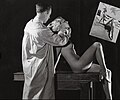Introduction

Nudity is the state of being in which a human is without clothing. While estimates vary, for the first 90,000 years of pre-history, anatomically modern humans were naked, having lost their body hair and living in hospitable climates. As humans became behaviorally modern, body adornments such as jewelry, tattoos, body paint and scarification became part of non-verbal communications, indicating a person's social and individual characteristics. Indigenous peoples in warm climates used clothing for decorative, symbolic or ceremonial purposes but were often nude, having neither the need to protect the body from the elements nor any conception of nakedness being shameful. In many societies, both ancient and contemporary, children might be naked until the beginning of puberty. Women may not cover their breasts if they were associated with nursing babies more than with sexuality.
In the ancient civilizations of the Mediterranean, from Mesopotamia to the Roman Empire, proper attire was required to maintain social standing. The lower classes might possess a single piece of cloth that was wrapped or tied to cover the lower body; the lowest classes including slaves might be naked. However, through much of Western history until the modern era, people of any status were also unclothed by necessity or convenience when engaged in labor and athletics; or when bathing or swimming. Such functional nudity occurred in groups that were usually but not always segregated by sex. Although improper dress might be socially embarrassing, the association of nudity with sin regarding sexuality began with Judeo-Christian societies, spreading through Europe in the post-classical period. Traditional clothing in temperate regions worldwide also reflect concerns for maintaining social status and order, as well as by necessity due to the colder climate. However, societies such as Japan and Finland maintain traditions of communal nudity based upon the use of baths and saunas that provided alternatives to sexualization.
The spread of Western concepts of modest dress was part of colonialism, and continues today with globalization. Contemporary social norms regarding nudity reflect cultural ambiguity towards the body and sexuality, and differing conceptions of what constitutes public versus private spaces. Norms relating to nudity are different for men than they are for women. Individuals may intentionally violate norms relating to nudity; those without power may use nudity as a form of protest, and those with power may impose nakedness on others as a form of punishment. (Full article...)
Selected general article

Freikörperkultur (FKK) is a social and health culture that originated in the German Empire; its beginnings were historically part of the Lebensreform social movement in the late 19th century. Freikörperkultur, which translated as 'free body culture', includes both the health aspects of being naked in light, air and sun and an intention to reform life and society. It is partly identified with the culture of nudity, naturism and nudism in the sense of communal nudity of people and families in leisure time, sport and everyday life.
By the 20th century the culture of communal open air nudity in the "great outdoors" and its benefits to public health blossomed in Germany as an alternative to the stresses and anxieties of Industrial Age urban life. Today, there are only a few legal restrictions on public nudity in Germany. Under the terms "naturism" and "nudism", it is now internationally widespread, with associations and designated public recreational environments in numerous countries in Europe, North and South America, Australia, Africa, Asia and the Caribbean; the largest distribution is still found in German-speaking countries and Scandinavia. (Full article...)
Did you know...
- ... that Meghan Trainor was inspired to write "Made You Look" after her therapist asked her to look at herself naked for five minutes?
- ... that Chris Ernst stripped naked in 1976 with her Yale University teammates to protest the lack of showers for the women's rowing crew?
- ... that César Mascetti was reportedly the first Argentine journalist to interview a member of the Beatles when he met a naked George Harrison on a Rio de Janeiro beach?
- ... that the music video for "It's OK I'm OK" was edited to make its singer appear naked?
- ... that the destroyed plinth of Gürdal Duyar's nude sculpture Güzel İstanbul contained reliefs of a fig, a pomegranate, a honeysuckle and a bee to represent different aspects of Istanbul?
- ... that Susanna Hoffs sang on the studio recording of "Eternal Flame" naked after producer Davitt Sigerson pranked her by saying that Olivia Newton-John had done the same thing?
- ... that former Scottish Conservative leader Ruth Davidson said that she would swim in Loch Ness naked if the SNP won more than 50 seats at the 2019 United Kingdom general election?
- ... that two nude bathers in Arnold Comes of Age were "nearly obliterated"?
Need help?
Do you have a question about Nudity that you can't find the answer to?
Consider asking it at the Wikipedia reference desk.
Get involved
For editor resources and to collaborate with other editors on improving Wikipedia's Nudity-related articles, see WikiProject Nudity.
Subtopics
Associated Wikimedia
The following Wikimedia Foundation sister projects provide more on this subject:
-
Commons
Free media repository -
Wikibooks
Free textbooks and manuals -
Wikidata
Free knowledge base -
Wikinews
Free-content news -
Wikiquote
Collection of quotations -
Wikisource
Free-content library -
Wikiversity
Free learning tools -
Wiktionary
Dictionary and thesaurus













































































